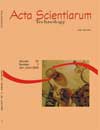<b>Influence of diets enriched with different vegetable oils on the performance and fatty acid profile of Nile tilapia (<em>Oreochromis niloticus</em>) fingerlings</b> - DOI: 10.4025/actascitechnol.v28i2.1169
DOI:
https://doi.org/10.4025/actascitechnol.v28i2.1169Keywords:
tilápia, Oreochromis niloticus, fatty acids, óleos vegetaisAbstract
The fatty acid profile of the carcass of Nile tilapia (Oreochromis niloticus) fingerlings fed diets enriched with different soybean, canola, sunflower, flaxseed, rice, and corn oils was examined. The results showed that palmitic (16:0), stearic (18:0), oleic (18:1 n 9), linoleic (18:2 n 6), and linolenic (18:3 n 3) acids were the predominant fatty acids in all vegetable oil, diet, and fish carcass samples analyzed. Flaxseed oil presented the highest amount of linolenic acid (45.63%), while the other vegetable oils had percentages lower than 5.0%. Neither of the vegetable oils used affected the performance of tilapia fingerlings and they can be utilized in Nile tilapia fingerling diets. However, in relation to the carcass fatty acid profile, the use of flaxseed oil in Nile tilapia fingerling diet is recommendedDownloads
Download data is not yet available.
Downloads
Published
2008-03-20
How to Cite
Matsushita, M., Justi, K. C., Padre, R. das G., Milinsk, M. C., Hayashi, C., Gomes, S. T. M., Visentainer, J. V., & Souza, N. E. de. (2008). <b>Influence of diets enriched with different vegetable oils on the performance and fatty acid profile of Nile tilapia (<em>Oreochromis niloticus</em>) fingerlings</b> - DOI: 10.4025/actascitechnol.v28i2.1169. Acta Scientiarum. Technology, 28(2), 125–131. https://doi.org/10.4025/actascitechnol.v28i2.1169
Issue
Section
Chemistry
License
DECLARATION OF ORIGINALITY AND COPYRIGHTS
I Declare that current article is original and has not been submitted for publication, in part or in whole, to any other national or international journal.
The copyrights belong exclusively to the authors. Published content is licensed under Creative Commons Attribution 4.0 (CC BY 4.0) guidelines, which allows sharing (copy and distribution of the material in any medium or format) and adaptation (remix, transform, and build upon the material) for any purpose, even commercially, under the terms of attribution.
Read this link for further information on how to use CC BY 4.0 properly.















8.png)




